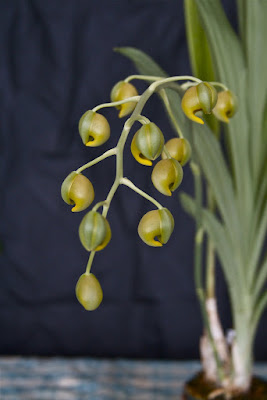Catasetum ochraceum is found in southern and southwestern Colombia, Venezuela, and possibly northern Brazil (states of northwestern Pará and northeastern Roraima). It grows on flat rock slabs, sandstone, disturbed forests and forest edges at elevations of 300 - 1700 metes above sea level.
Catasetum ochraceum also called as The Ochre-Yellow Catasetum, Catasetum inornatum, Catasetum lehmannii, is a species of the genus Catasetum. This species was described by John Lindley in 1844.
IDENTIFY CATASETUM OCHRACEUM ORCHID PLANT
Catasetum ochraceum is found in southern and southwestern Colombia, Venezuela, and possibly northern Brazil (states of northwestern Pará and northeastern Roraima). It grows on flat rock slabs, sandstone, disturbed forests and forest edges at elevations of 300 - 1700 metes above sea level.
It is a small to medium sized, hot to cool growing, lithophyte, epiphyte or terrestrial with fusiform to ovoid, to 30 cm long and 5 cm wide pseudobulbs subtended by leaf bearing sheaths and carrying 2 to 3 apical, plicate, narrowly elliptic, to 40 cm long and 10 cm wide leaves.
The Ochre-Yellow Catasetum blooms in the summer and fall on a basal, erect, 50 cm long, racemose, several flowered inflorescence arising on a mature pseudobulb. The male flowers are 2 cm in diameter with coloration of sepals and petals green, outside sometimes with faint red speckles, even a strong red flush; inside of sepals with larger and darker spots; inside of petals with transverse red-pink striping; lip yellow-green outside, orange inside with fine red striping; lip apex orange; column orange-gold; anther green and yellow. The female flowers are 40 × 45 mm with coloration of flowers green with faint, darker, longitudinal stripes in the bottom of the lip sac and red spotting at the base of the petals.
This species is distinguished from other members of the Catasetum luridum alliance by the arrangement of the flowers on the erect male inflorescence (widely spaced apart), by the trough-shaped lip with a cordate (heart-shaped) base ending in a thick, semicircular, flat lobe, and by the fairly consistent dark yellow color.
CATASETUM OCHRACEUM ORCHID PLANT CARE AND CULTURE
Cultural information should only be used as a guide, and should be to be adapted to suit you. Your physical location; where you grow your plants, how much time you have to devote to their care, and many other factors, will need to be taken into account. Only then can you decide on the cultural methods that best suit you and your plants.
Light:
Catasetum ochraceum are sun-loving plant and needs a light level of 30000-60000 lux. Needs light to moderate shade (40-60% shade) if male flowers are desired. This species can be grown under lights if sufficient light intensity can be provided, and the plant certainly can be summered outdoors if their moisture requirements can be met.
Temperature:
In their natural habitat, the climate is evenly hot, moist, and tropical. This climate is almost the same year-round, with high humidity at night, even in the dry season, which is relatively short. The nighttime temperatures rarely fall below 18°C, with daytime highs generally from 29 to 35°C. The important thing is to maintain evenly warm conditions, and for this orchid the closer the night minimum is to 21°C, the better the plants will respond.
Humidity:
The Ochre-Yellow Catasetum tolerate an environment with 40 - 60 % relative humidity during their growing season, but for optimal development of new growth and flowering, 70 % is recommended.
Substrate, growing media and repotting:
Catasetum ochraceum can be grown conventionally potted in bark mix, in spite of its terrestrial and rupicolous background. It is recommended to repot every year and never wait more than two years. The optimal time for potting or repotting is when new growth on a plant emerging from dormancy is about 5 cm tall and the nubs have developed into new roots that are reaching for support.
Watering:
In its natural habitat it receives rainfall frequently even while dormant. Mounted, basket-grown, and unconventionally potted plant may be watered every sunny day during the growing season, provided conditions are such that they dry off relatively quickly. In the case of conventionally potted adult plants, it should not be necessary to water more than once or, at most, twice a week. This species like to dry out at least slightly between waterings. Watch carefully for rot in the pseudobulbs.
Fertilizer:
Fertilize with an appropriate formulation at least every week during the growing season, or fertilize with a weak formula every time the plants are watered. It is important to begin regular applications of high-nitrogen fertilizer (such as 10-5-5) with a full range of trace elements. As the leaves begin to unfurl, and well before flowering, add a high-phosphorus formula to develop big, strong pseudobulbs capable of producing robust inflorescences. Any of the soluble products with a large second-digit number (for example, 3-12-6) constitute a good source of phosphorus.
Rest period:
Catasetum ochraceum have a relatively short dormant period between leaf fall and new growth, and sometimes no dormancy at all, so the likelihood that at least some of their basic root system will survive from one growing season to the next increases. For this reason it is desirable to maintain a watering schedule, albeit reduced, during dormancy.















COMMENTS